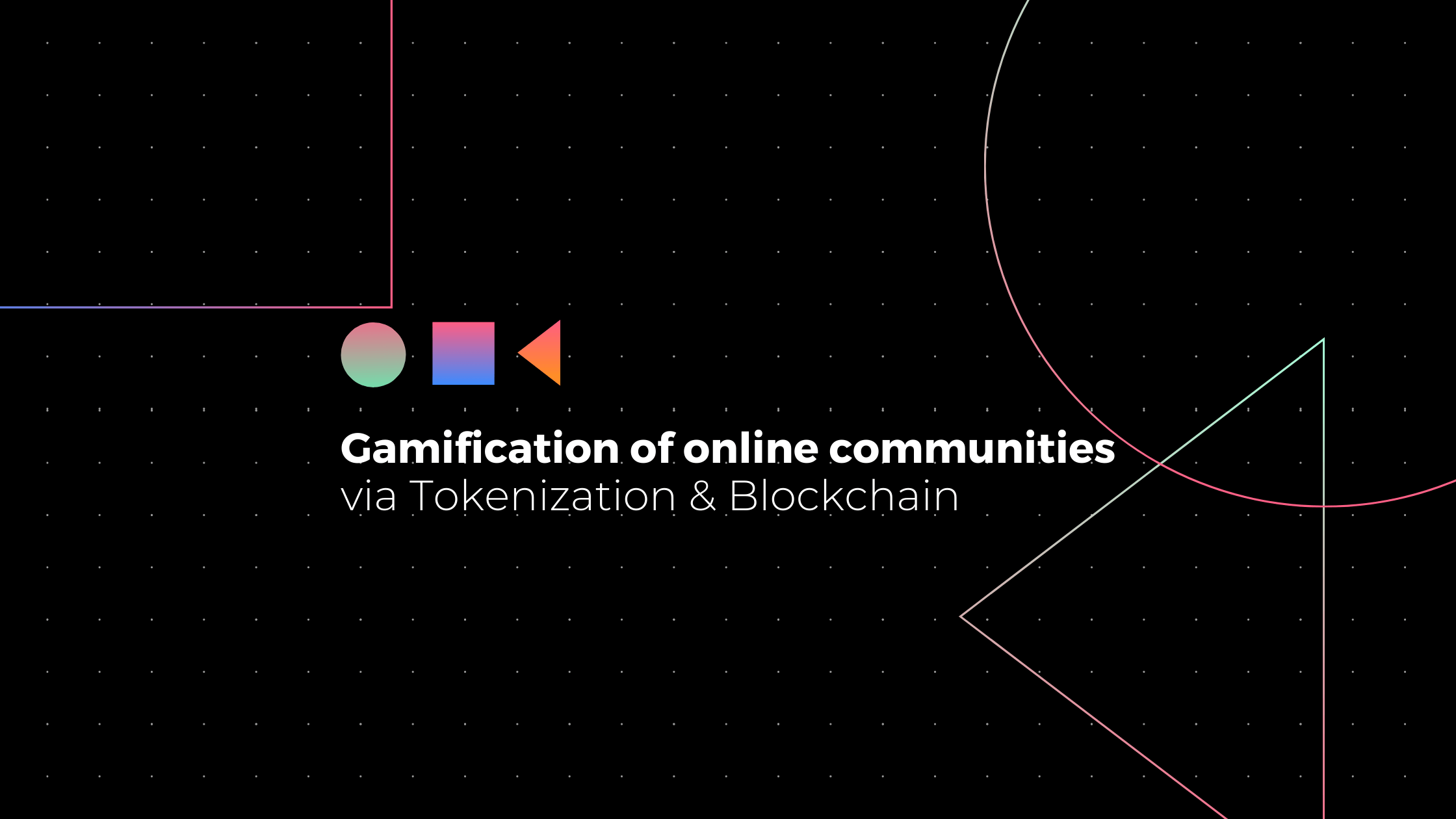Online games! Everyone is smitten by them. A joy of contesting with dozens of online users. Interestingly alluring prizes to be won. Gamification is one such absolute way to enhance user engagement. Yes, you heard it right.
How can you get community people involved through gamification? Well, here’s an article that will help you understand everything about the gamification of online communities through tokenization.
What does gamification mean?
Gamification implies the application of several encouraging factors such as points, rules, and competition with other fellow users to create playful experiences for the users.
Putting it in simpler words, gamification means to trigger the emotions of the people and motivating them to participate by providing incentives. Our devices such as laptops and mobile phones are packed with dozens of software that use the non-game factors to attract and inspire you.
For example, Healthcare and fitness deploy gamification to engage the users. The users are rewarded for completing the mandated tasks and their performance is rated for different gamification elements. The irresistible desire to unlock different levels keeps the users moving.
In a nutshell, gamification is all about stimulating the progress-related instincts of an individual and rewarding them.
Examples of Popular apps which use gamification for user engagement:
- Forest: The Forest App deploys the concept of tree planting to keep you glued towards your work. When you start working you ‘plant a seed’. If you stay focused and complete your work, the seed you planted grows into a tree. If you fail to do so, the tree withers.
The more you work, the more seeds you plant and finally the bigger and lusher forest you have. Isn’t that interesting?
- Fitbit: Fitbit is a wearable fitness tracker that has rich gamification features such as badges and challenges to motivate users to accomplish their set goals. You can also invite your friends and peers to do some awesome sport-challenges with them. Hurray!
How should you use the gamification elements?
When designing the gamification elements, look at the larger picture. How can the gamification element be useful to a large part of the community? The users must be recognized for their sincere commitment and contribution to the online community.
Make sure you add elements that push people to extend their network. This helps in building a strong online community. Use rewards such as badges, scores, or anything else that you want to humanize the concept of gamification. Avoid making rewards a sole basis to leverage transactional activities.
Some important Gamification Elements
- Accomplishments/Badges: They are displayed publicly and display the interest, engagement, and achievement of the user.
- Progress Tracking: Offers quantitative elements that showcase the achievement of the user. This is a private metric.
- Collectibles: Process that measures all the virtual resources of the user depending on their engagement levels.
- Challenges: Refers to a set of tactics that are deployed to motivate the users to expand their results. Challenges excite the participants to move to higher levels.
- Leaderboard: Leaderboard allows the participants to evaluate their performance ranks. The user can generally see some of the users who are above and below his level.
- Competence and Proficiency: Competence refers to the skills that are required to fulfil a certain challenge. Proficiency refers to the speed with which an individual completes the specific challenge.
- Community Ethics: Community ethics refer to the culture. It focuses on the techniques that push the participants to indulge in online community activities.
- Competition: Competition refers to the different sets of cut-throat activities where the users contest to showcase their skills and adeptness.
- Surprise: Surprise entices the users to take or fulfil a specific action to get an enticing surprise.
- Virtual Economy: The virtual economy establishes a supply and demand environment where the active users are motivated to spend their credits to get rewards. The users can buy new credits and virtual assets in two ways. They can either buy them directly from the market or achieve them through the completion of several tasks.
- Participation: This refers to a group of activities that enable the participants to engage in the decision-making activities of the online community, catering to different needs.
Important points for community managers
The community managers must have a basic understanding of all the gamification concepts to implement gamification successfully. They should know how they can strategize the application to drive the best results.
- Participant Behaviour: Research to find out the behaviour of the community users. What are their goals? What value do they want to extract from the online community?
- Find answers to these questions to ensure before you align your gamification plan.
- Attainable goals: Always start with reachable goals. Put in small goals. People would love to accomplish them.
- If your goals are too complicated, the users may perceive them as scarcely credible. They’ll opt out.
- Design your goals in an incremental order so that the users can advance towards them. The gamification strategy must cast back your brand and its mission to serve the community members.
How can you lead on user engagement through gamification?
Here are some powerful ways that will help you drive community engagement:
- Share on Social Media: Recognize the users who share community content on their social media handles. This serves a dual purpose. First, the community gets access to quality content. Second, the users get some extra points for sharing valuable insight with their fellow users.
- Deliver Value: Some gamification users are full of vim and vigor. They’ll quickly check all the features of your application. Well if that’s the case why not reward their inquisitive instincts. Offer them badges such as “Quick-Learner” to appreciate their enthusiasm.
- Loyalty Program: When designing the gamification plan, incorporate a customer loyalty program. This program works ideally for customers who offer a valuable contribution to the digital space.
- Personalize your interaction: The users are bombarded with tons of information every day. How do you ensure to stay on top of their minds? Humanize your interactions with them. Keep the users hooked. This ensures your brand is the get-at-able for them. Ensure you are obtainable.
- Control: Users define your online gamification community. Undoubtedly, you as the community manager are solely responsible for your community. However, you need to ensure that your customers are being served value and must feel that they are running the show. Value their participation.
- Consistency is the key: How long do you engage your customers? Make sure you extract an honest answer to this question. Your gamification activities must maintain momentum throughout. Are you highly active one day and then slumbering for the next few days?
If that’s the case, recheck your gamification plan. Ensure you maintain consistency.
Combining Blockchain/tokenization
Blockchain is one of the innovative ways to leverage the gamification of online communities. This helps your brand stay on the top throughout the customer’s journey. The tremendous power of tokenization allows incentivizing the direct engagement to the gamification ecosystem by overcoming all the hurdles.
Here’s how blockchain technology works with gamification:
- Simplify transactions: Blockchain allows the conduction of smooth transactions through its tokenized system. It has streamlined the process of data collection, comprehending the preferences of the users, and putting the extracted information to advantage in a rightful manner.
- Transparent: The sound gamification mechanisms ensure that the entire gamification scenario is clear and transparent. Generally, there is a misconception about gamification. Users believe it is only profitable to the entity that is putting them forward.
- Tokenization strengthens the user’s trust and encourages them to spend their money and time. The users can verify the performance of the service.
- Immutability: The tokenization ensures none of the applications and data can be vandalized by parties involved or third parties. This corroborates that the users will not lose their obtained results and recognition.
- Authentic: All the information reported through blockchain is unquestionable once it has been duly approved by the affiliated organizations. This assures the users that the complete information available is genuine.
- Interoperability: Presently, gamification focuses on a single brand. However, the incorporation of blockchain with gamification allows the transfer of virtual resources outside the barriers imposed. For example, the credits earned by one trainer could be transferred to another trainer.
Wrap-up:
Is gamification a matter of motivation?
Indeed, it is. It is a perfect blend of both intrinsic and extrinsic motivation factors. Intrinsic, as the users are keen to take on the tasks because they enjoy doing them. Extrinsic, as external elements such as badges and prizes fan their flames.
Well, that’s icing on the cake. All these factors propel the users to dive deep into the gamification arena and display their zeal and enthusiasm.
Now that you know what drives the users, it is important to have a concrete gamification plan. Your gamification approach must not sound deal-making. Rather, it should deliver an immersive experience to the user.


